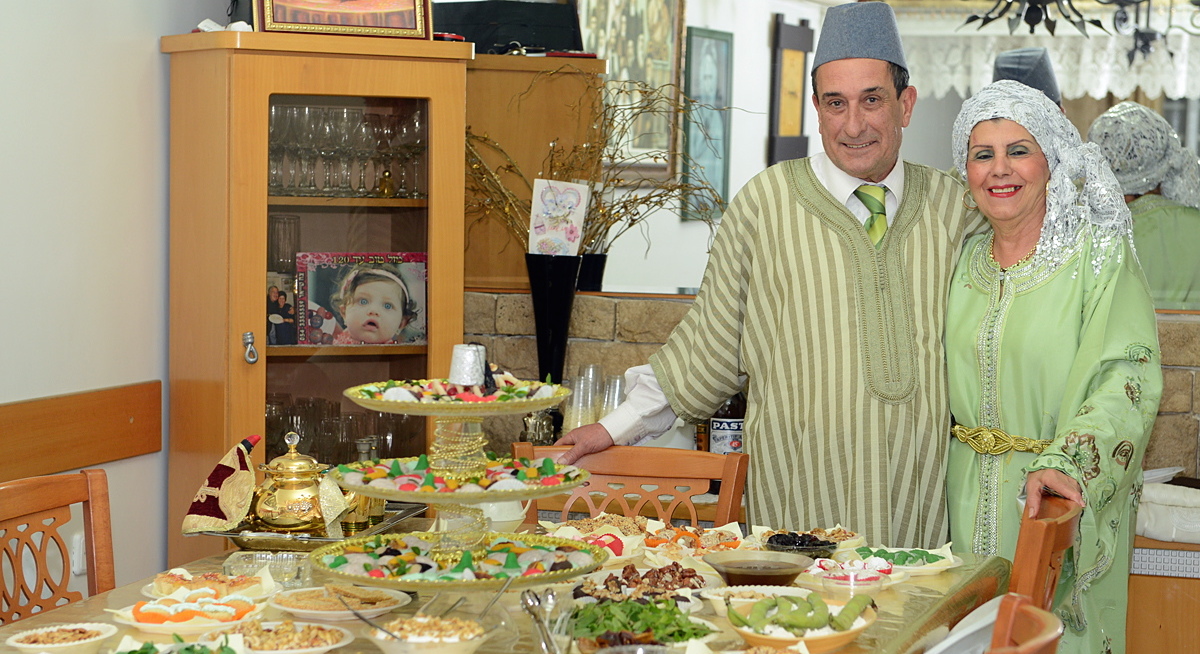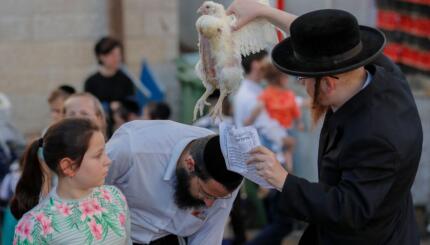A Jewish custom — known in Hebrew as a minhag — is a religious practice that, though sometimes very widely practiced, does not carry the force of Jewish law and is thus not considered mandatory by traditional Jews.
Customs cover an extremely wide range of Jewish rituals, from variations in the order or language of particular prayers to swinging a chicken over one’s head prior to Yom Kippur to the nearly universal practice of smashing a glass at the conclusion of a wedding ceremony. Customs typically have folk origins, but there are instances in which they may have been imposed by religious authorities. Other customs were maintained for so long and adopted so widely that they have become enshrined as obligations in Jewish legal codes and are no longer, strictly speaking, customs at all. Still others may have been adapted from practices of the cultures in which Jews lived and were only later sanctioned by Jewish authorities.
Halacha (Jewish Law) vs. Minhag (Custom)
Jewish law is called halacha (literally the path or the way) and is grounded in the Torah itself or later rabbinic rulings.
In the former category are obligations that are explicit in the Bible, such as prohibitions on murder, idol worship and certain sexual behavior.
Rabbinic laws are of two types:
- A gezerah (literally “fence”) is a rabbinic rule imposed to serve as a guard against violating a more serious prohibition, such as the ban on touching objects used to perform forbidden actions on the Sabbath;
- A takkanah (literally remedy or fixing) is a piece of rabbinic legislation enacted for some other purpose, such as the celebration of the holiday of Hanukkah.
Customs are established practices that are not legally obligatory and do not derive from biblical or rabbinic mandates. They cover a very broad range of religious practices, including (but not limited to):
- The manner, order and liturgy of prayer;
- Certain wedding rituals;
- Styles of Torah chanting and of decorative Torah scroll coverings;
- Various holiday practices.
Sephardic Custom vs. Ashkenazi Custom

Many customs differ based on Jews’ ethnicities — Ashkenazi and Sephardic Jews observe many different customs from one another. Among them is the custom that Ashkenazi men begin wearing a prayer shawl only once they are married, while Sephardic custom is generally from a boy’s bar mitzvah. (Many liberal Jewish women also wear prayer shawls.)
However there are also a vast number of variations in customs even among Ashkenazi and Sephardic subgroups. The post-Passover celebration of Mimouna, for example, is a custom that originated among the Sephardic Jews of North Africa. The wearing of long curled earlocks (payot) is a custom practiced generally only by Hasidic Ashkenazi Jews.
From Custom to Law
Some practices that began as customs became so well established in Jewish life that they are now broadly considered obligatory. One example is the wearing of a kippah by men. (Many liberal Jewish women also wear kippot.) The practice was described in the Talmud as the pious habit of a particular rabbi and codified by later rabbinic authorities as required at particular times — for Maimonides, during prayer ; for the Shulchan Aruch, when walking more than four cubits. (The Shulchan Aruch elsewhere records the view of some authorities that it is forbidden to recite God’s name when not wearing a head covering.) In the 20th century, the American Orthodox authority Rabbi Moshe Feinstein issued a special dispensation for men to not wear a kippah at work if necessary — implying that the practice is generally obligatory.
Another example is the Ashkenazi ban on eating rice, lentils and legumes — known as kitniyot — during Passover. Though the practice of avoiding rice on Passover is noted in the Talmud, it only came into force as a broad ban centuries later. The ban remains in force among most Ashkenazi Jews today, though the Conservative movement, in a 2015 decision, overturned it.
Over the centuries, rabbinic authorities have employed various formulations to describe the obligatory nature of longstanding customs. When discussing the practice of observing a second day of festivals outside of Israel — originally instituted to ensure the proper day of the holiday was observed in places where word of the new month took a long time to arrive — the Talmud asks why the practice persists even after the establishment of a fixed calendar made it unnecessary. The Talmud replies: “Take care to observe the customs of your fathers that you received.” The Tosafot (scholars in 12th- and 13th-century France and Germany) commentary to the talmudic tractate Menachot asserts that the customs of our fathers are equivalent to Torah commands. And Maimonides, in the introduction to his Mishneh Torah, writes that it is forbidden to depart from customs that came into practice with rabbinic sanction.
Non-obligatory Customs
Contemporary Jewish life is replete with examples of customs that have no obvious basis in biblical or rabbinic law but are nonetheless practiced — sometimes widely, sometimes only by particular communities. In the former category are various customs for Jewish weddings, including the bedeken ceremony — said to be inspired by the tricking of the biblical patriarch Jacob into marrying Leah instead of Rachel, but not mandated by the Bible or the Talmud — and the breaking of the glass at the ceremony conclusion. The latter custom, noted in the Talmud but not presented there as a religious obligation, was, only after it had been observed for generations, accorded a Jewish explanation: At the moment of our greatest happiness, we remind ourselves of the destruction of the ancient temple in Jerusalem.
A controversial practice — never mentioned in the Torah or Talmud and fiercely opposed by some rabbinic authorities — is the custom of kapparot prior to Yom Kippur, in which a live chicken is symbolically invested with a person’s sins and then ritually slaughtered. Most Jews have abandoned the practice entirely, or perform it with money instead of a chicken, but it is still common among Hasidic Jews. A more popular High Holidays custom — based on a biblical verse but coming into practice only in the 13th century — is the ritual of Tashlich, in which a person symbolically casts his or her sins into a moving body of water on Rosh Hashanah.
Some customs are practiced by only small minorities of Jews. German Jews, for example, ritually wash their hands before reciting the Kiddush prayer over wine at the Sabbath meal, while most other Jews wash their hands after drinking the wine. Some Jews stand for the Kiddush, others sit, and some stand for the first half and sit for the second half.
Among the Jews of Gibraltar, sand is added to the charoset dish on Passover to enhance its symbolism of the bricks used by the Hebrew slaves to build in ancient Egypt. Another unusual Passover custom, practiced by Persian Jews, is to whip seder participants with scallions in remembrance of the pain of bondage.
Ashkenazi
Pronounced: AHSH-ken-AH-zee, Origin: Hebrew, Jews of Central and Eastern European origin.
Talmud
Pronounced: TALL-mud, Origin: Hebrew, the set of teachings and commentaries on the Torah that form the basis for Jewish law. Comprised of the Mishnah and the Gemara, it contains the opinions of thousands of rabbis from different periods in Jewish history.
minhag
Pronounced: MINN-hahg, Origin: Hebrew, Jewish custom, or group of customs.
Sephardic
Pronounced: seh-FAR-dik, Origin: Hebrew, describing Jews descending from the Jews of Spain.
halacha
Pronounced: hah-lah-KHAH or huh-LUKH-uh, Origin: Hebrew, Jewish law.
halachic
Pronounced: huh-LAKH-ic, Origin: Hebrew, according to Jewish law, complying with Jewish law.
Hasidic
Pronounced: khah-SID-ik, Origin: Hebrew, a stream within ultra-Orthodox Judaism that grew out of an 18th-century mystical revival movement.
kippah
Pronounced: KEE-pah or kee-PAH, Origin: Hebrew, a small hat or head covering that Orthodox Jewish men wear every day, and that other Jews wear when studying, praying or entering a sacred space. Also known as a yarmulke.
kitniyot
Pronounced: kit-nee-YOTE, Origin: Hebrew, meaning “little things,” the term here refers to legumes, corn, rice and other non-hametz foods prohibited for use on Passover by some Ashkenazic rabbis in the medieval period. Many Sephardic Jews (and Conservative Jews) do allow them on Passover.
Kiddush
Pronounced: KID-ush, Origin: Hebrew, literally holiness, the blessing said over wine or grape juice to sanctify Shabbat and holiday.
bedeken
Pronounced: buh-DEK-in, Origin: Yiddish, part of a traditional Jewish wedding ceremony, when the groom symbolically checks under the bride’s veil to make sure he is marrying the right person, an allusion to Jacob accidentally marrying Leah, instead of Rachel, in the Torah.



